
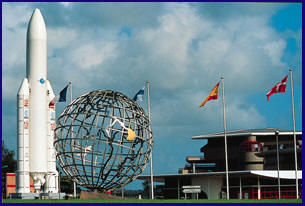 |
Entering Guyana Français was "interesting"! The whole shelf where the three Guyanas are located (known as the Guyana Shield) is very shallow, much of it less than 2 meters for miles out, so impossible for boats like us to approach. Kourou, of the Ariane Space Centre fame, has a 6 mile long dredged and buoyed channel to allow deliveries of rockets & satellites to the centre. It's marked clearly on all the charts, but curiously the depth isn't noted. Got to be more than our 2.1 metres if freighters go in there we reasoned. Just to colour in this picture a little more: as well as there being a long narrow entrance channel through soupy, muddy water, the Guyana current runs at between 2 & 3 knots at right angles to the channel. If you're a sailor you know what that means, but if you're not it means if your motoring ahead at 3 knots then for every mile you go forward you also move a mile sideways (and the channel is not very wide). You can mitigate the effect by going faster, but going faster is not necessarily something you want to do in a shallow channel, where you aren't sure of the depth. So, in order to stay within the channel you have to steer a course at about 45 degrees to where you want to go. This is one thing in open waters where you can make periodic corrections if you haven't got the angle quite right, but quite another in a narrow channel with shallow water on each side and the marker buoys about a mile apart. It's obviously a lot easier with GPS, but even so, pretty scary. This isn't The Solent and if you do go aground you can't expect anyone to come by and pull you off. Just add to this that the liquid crystal segments on our depth gauges have had enough of tropical sunlight and are periodically switching themselves off making the depth something of a guessing game - now you have the complete picture. |
|
We left the Isles de Salud (of which the most famous is Devils island of Papillon fame) to starboard, identified the seaward buoy and entered the channel. Lindy is steering and Barry mostly below decks monitoring GPS and navigation computers, just sticking his head up from time to time to check reality. 10 degrees to starboard. Now come 5 to port, etc, etc runs the conversation. We're coming in on a flood tide and the sea is calm, so if we do go aground the tide will lift us off as it rises. This means the tidal flow is carrying us in at about 2 knots. Normally good news, but as we are trying not to do more than 4 knots over the ground, our speed through the water is reduced to about 2 knots, reducing the water flow over the rudder and making steering sluggish. To give us an additional margin of safety, we're favouring the port side of the channel so that the current is always pushing us towards the centre of the channel. What we won't know until much later is that the dredger that normally works every day keeping the channel clear, has been in Cayenne for 2 weeks for maintenance. Driven by the Guyana Current the channel is slowly being filled with mud - From the port side! Everything goes OK for the first couple of miles. We seem to have got the hang of the drift, the depth isn't toooo bad and we're feeling more comfortable. Just over half-way and the depth starts to drop away. Less than half a meter under us, 0.4, 0.3 and finally the magic number of 0.0. "We have no water" calls Lindy, turning to the right. Maybe I left 0.1 for luck when I set the transponder up - I didn't. Lindy again - "We're slowing down. We've stopped". The tide will float us - we just need to wait. When it does - do we carry on in or do we back out and skip French Guyana? Before we can even begin to discuss it we're moving again. The depth is still 0.0, but we're moving. Then it's 0.1. We're going so slowly we're being pushed into the centre of the channel. The depth and speed continues to increase. According to the chart in another mile the channel widens and the depth really begins to increase. And so it proves to be. Huge sighs of relief when we have 0.5 M! Don't want to do that again. Another hour and we anchor in the river, off Kourou - hope it's worth it. And was Kourou worth it? I thinks the answer is - probably, since we were passing anyway. It's an odd sort of place, full of contradictions. It is completely different from Brasil, with much more of a Caribbean feel. The fishing quay, where we went ashore, and the adjoining fish market are among the scummiest we'd come across in our time in South America. This impression was reinforced by the flocks of vultures feasting on decaying fish entrails and the like in the swamp adjoining the shore. The street leading from the quay was a mixture of gaily painted Caribbean houses and restaurants and other buildings ranging from dilapidated to derelict. Overall though the ambience (once past the vultures) was a pleasant one and as the French government have now earmarked millions of Euros to refurbish the area it can only get better. We should also add that Kourou has the friendliest customs and immigration official we have ever met! After that one street, Kourou becomes a sprawling small-town of low rise modern buildings without any definable centre. The town originally developed as a disembarkation and supply centre for the penal colonies on the Isles de Salud. And since their closure it's raison d'être has become to house the people who work for, or support, the space centre. Virtually everything is imported from France, the prices are about 40% higher than Paris, and for us, after so long in South America, slightly shocking - Tomatoes in Brasil next door for 0.30 Euros/Kilo. Here in Kourou 5.00 Euros/Kilo. How can that be???
It was nice enough for a week or so, being brought crusty French bread with your meal, instead of a bowl of beans, just seemed so civilised. There was an Ariane launch due, the dredger was back in service working day and night to clear the channel for a delivery ship - so with a freshly dredged channel and spring tides approaching it seemed time for us to heave anchor and head for Suriname. As Lindy helmed into the channel against the incoming tide the sea was far from calm and we were being bounced by the waves, she could see the dredger/pilot boat in the distance and heard the incoming ship arrange to meet it at the sea buoy before entering the channel. We increased speed and headed towards them, it would take nearly an hour - there was little time to keep checking the non-functioning depth gauge! It was a wet exit but we were glad to be leaving. |
|
|
||
| Two days later - Paramaribo, the capital of Suriname is approached via a similar channel, except
it's deeper, wider and has much more big ship traffic. So you can let them
pass and watch where they go. We anchor up the river in front of the Hotel Torarica - Suriname's top hotel. There are a couple of other yachts
anchored there including Len & Janna on 'Present' a Dutch yacht that we had
briefly met in Kourou and Jacaré. They arrived a few days earlier and are
able to fill us in on all the essential info. Where to clear in, where the
markets are etc. Most shockingly they tell us that the Torarica
charges 50 Euros per night for yachts to anchor off their jetty and use their
facilities! What? "But we don't know anyone who's ever paid them
anything" they tell us. "You just walk through reception without making eye contact, talking
in English and generally trying to look like an American tourist. Seems to
work so far." And indeed it worked for us. After a few day we felt
comfortable enough to start asking the receptionist to book us dental
appointments.
Suriname is an amazing
ethnic and cultural melting pot - Indians, Chinese, Javanese, Africans are the
major, though by no means only, ethnic groups. And they all seem to rub along
without any visible friction and have produced one of the friendliest nations we
have visited. This must be one of the few places in the world where the central
mosque and the central synagogue share a car park! |
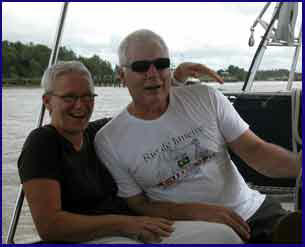 |
|
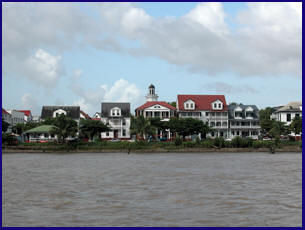 |
All of this cultural mixing takes place with Dutch as the first language and in the most Dutch of landscapes, which gives the whole experience of being here a slightly disjointed, surreal feeling. We instinctively liked Suriname. The same process that has produced such friendly vibrant people, seems also to have created the most tortuous bureaucracy we have yet experienced. After 4 days and numerous visits to multiple agencies, often in obscure locations, we still hadn't been able to clear in or get our passports stamped - though nobody seems to care. The Customs man has said he will visit the boat to check stores etc before he will stamp our papers. With the knowledge that importing meat and fruit is prohibited we debate how best to conceal two large vacuum packed Brasilian filets of beef, which are in the fridge and a large quantity of green bananas. Is he going to notice us running to the anchor locker with a large plastic bag? Our concerns are of course groundless. Len & Janna were told the same thing and have been calling him every day for over a week to try and get him to come inspect the boat and stamp them in. Further investigation reveals that he does not have a boat, a VHF radio, or even a car. So a visit is unlikely. |
|
|
We understand that there is something of a cruising community a few miles further up the river at Domburg and they will be having a Christmas Eve party. We plan to go. Len and Janna are now cleared in and set off. We will follow on Christmas Eve. Or actually, as it transpires, not. We're ready to go, just waiting for a squall to pass. We've lifted the outboard and got the dinghy on deck and just as we're thinking of leaving we notice that there's a Dutch boat anchored just off our starboard beam. Nothing strange about that, except 5 minutes ago it had been anchored a couple of hundred yards further down river. The anchor has obviously dragged and there's no-one on board. Dragging is a real problem here. The bottom's very soft and the tide fairly rips through the river. It's bad luck that we've just lifted our dinghy, so we can't quickly get across and try and get another anchor out, if they have one. It'll take us 30 minutes or so. Also, it seems to have stopped dragging. Possibly, the anchor has re-set. We take a bearing and wait. Take another one. No it seems to be set. We still don't want to leave until the owner returns. So we settle down to taking periodic bearings and being prepared to put our dinghy back in the water if necessary. The owners finally return - we know how it feels to find your boat somewhere other than where you left it. We let them know that we've been baby sitting and it now seems to have been set for a couple of hours, but they decide to re-anchor just to be sure (we would have done the same). It is now too late to catch the tide to Domburg so we open a tin for our own Christmas Eve party and will head up river tomorrow.
Domburg. Hmmm. What can we say? We've come across a number of places as we've travelled where sailors fetch up, get stuck and just sort of stay. Domburg is one of those places. Domburg is a collection of one story shacks serving as bar/restaurants around a beaten earth square. They have no running water or drainage and only one bar has a toilet - that is it has a toilet bowl. It does not have water or drainage. The square has overflowing rubbish bins, a resident mango-selling junky and packs of the scabbiest feral cats and dogs we have yet encountered. Why is it the most flea ridden are always the friendliest?? There are two small Chinese supermarkets, a few vegetable stalls, a filling station which sometimes has fuel, and a daily bus to Paramaribo. I don't think I've missed anything. |
||
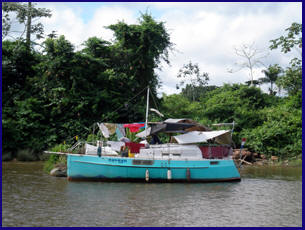 |
A handful of mainly Dutch boats have settled here and one or two crews have bought houses. The days seems to centre around meeting in Rita's bar in late afternoon and watching the world (or at least Domburg) go by. And since the population of Domburg numbers a couple of hundred at most, there's not much to watch. All that said, it's a friendly enough place and if you enjoy cold Nasi Goreng and Satay, have a high tolerance to flea bites and are thinking of writing the definitive Dutch novel, Domburg could be just the place you're looking for. One couple who have settled, without completely falling into the rut, are Ed & Sofía on the tiny yacht Ergo. They haven't acquired land or property, they've created it. They've actually built their own island. They've collected old water and lemonade bottles and a big old fishing net. They've tethered all of this to their boat, covered it with soil and planted a garden, complete with vegetable patch, banana tree and gazebo. It is now many times bigger than their yacht, but it is very much tethered to the boat and not the other way round. This would be interesting prime real estate if they were ever to tow it somewhere other than Domburg. |
|
|
Well we stayed for New Year, but after a week or so square-watching was losing it's already marginal appeal, and the flea bites were driving us crazy. So, in the company of Present (also Domburged out), we headed back to Paramaribo. We hired a car with Present and the German yacht Akka. There are two oddities with driving in Suriname. Due to some weird hangover from the past they drive on the left, but they will only accept a Dutch and not a UK licence even though (as EU licences) they are in all respects identical except for the letters NL or UK in the top left hand corner. Thus the only people comfortable driving a right hand drive car on the left hand side of the road were prohibited from doing so. Anyway, we did a big shop, cleared out with immigration, and sat at the customs officers desk until he finally cleared us out as well. Then just before we left we sat and watch as the American yacht Juno (with it's engine temporarily out of action) become the final victim of the soft bottom as it dragged into Akka, catching their bow and tangling their anchor chains. That took some sorting out! |
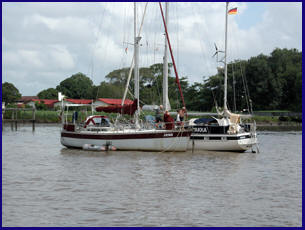 |
|
|
||
|
Next stop the Caribbean.
|
||